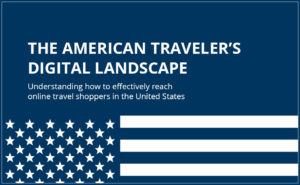By Expedia Media Solutions
For online travel shoppers, the purchase journey is complex. From the inspiration, research and consideration phases to the booking phase, the process may include many twists and turns while navigating online travel information, OTA, hotel and airline sites, and more. With an understanding of the intricate online booking journey, brands can connect with travelers and influence their purchases.
A new study on the Traveler’s Path to Purchase from Expedia Media Solutions and comScore reveals trends in how online travel shoppers in the U.S., U.K. and Canada choose destinations and make travel purchases.
The study found that Americans spent 8.7 billion minutes on digital travel content during a 15-month period, more than a 40 percent increase year over year. In the 45 days leading up to an online travel purchase, American shoppers visit travel sites an average of 140 times, and as they get nearer to making a purchase decision, they seek out even more content and spend a significant amount of time conducting online research and planning.
During this booking journey, American travelers are also paying attention to advertising: 32 percent said advertising or word of mouth prompts their research and exploration of a trip. The impact of advertising is further illustrated in that nearly half of travel bookers recall seeing a travel ad while shopping for or booking travel. This presents a great opportunity for travel marketers to reach and influence the online booker throughout their travel path to purchase.
Here are three ways to influence online travel bookers:
1. Create efficiencies for travel bookers by creating compelling content that can be accessed across devices. The digital industry in the U.S. is expansive: there are 258 million people who engage with digital content across screens (desktop, mobile or tablet), and of those, three out of five people specifically spend time on travel content. American digital travel shoppers are increasingly interacting with travel content on mobile devices, which reaches more consumers than desktop. As multi-platform usage increases, consumers expect a cohesive, integrated content experience, regardless of which screen they are using.
2. Leverage online channels and partnerships that provide efficient and scalable reach through all phases of the consumer booking journey. The top resources that U.S. travel shoppers initially use to choose a destination include OTAs, airline sites and family and friends. They consistently use OTA, airline and hotel sites throughout the duration of the purchase path, relying less on other resources as they get closer to booking. It’s crucial for travel marketers to take note of when and how shoppers use different resources in order to create an effective and fully integrated approach.
3. Consider shopper habits and influential touch points throughout the entire booking journey to determine marketing objectives and create an integrated strategy. The best opportunity for travel advertisers to influence and maintain share of voice is at the initial point of consumer inspiration. This phase of the online booking journey is when ad penetration is lowest and recall is highest. For travelers who are considering multiple destinations, advertising can make an impact — it influences 27 percent of those who are undecided. Targeting effectively reaches travel consumers, as bookers are four times more likely to see travel advertising than non-bookers. By taking into account the entire path to purchase, marketers can optimize their reach and effectiveness to influence consumer purchase decisions.
-> Attendees at eTourism LABS on March 14-15, 2017 will hear directly from Derek Price, Director North America, Expedia Media Solutions.
For more on how to effectively reach the American travel shopper, download the full white paper here, download this visual, which shows a sample path to purchase from the study.




Leave a Reply